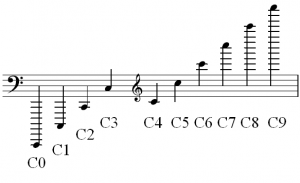Often when we talk about pitches, we make reference to where it falls in the singer’s voice (e.g., a soprano’s high E versus her low E) or in relation to the piano’s middle C.
This system mostly works, but it can sometimes lead to some confusion. For instance, many sopranos can sing three Cs: the one below the staff, the one in the staff, and the one above the staff. If we called the one above the staff her “high C” and the one below the staff her “low C,” would that make the one in the staff her “middle C”? That’d be really confusing, because the piano’s middle C would be the soprano’s low C.
To solve this confusion, there are three main systems for naming pitches in America: scientific pitch notation, Helmholtz pitch notation, and MIDI note numbers. Of these, the last is useless for choirs and the second can be somewhat confusing.
The most straightforward and practical for you and your choir to learn is scientific pitch notation. This is the system we use on Mormon Musician.
In this system, octaves span from C to B, and each octave has a specific number. In scientific pitch notation, the piano’s middle C is C4. The rest of the notes in a chromatic scale following that pitch would all be in octave 4 — C#4, D4, Eb4, etc. — until you reach the next C, the mid-staff C. Scientific pitch notation calls this note C5. In turn, the soprano’s high C is C6.
The same principle extends down into the men’s ranges, too. A tenor singing the piano’s middle C also sings C4, just like the soprano singing her lowest C. Although C4 falls in a different place in the ranges of a soprano or a tenor, scientific pitch notation calls this pitch the same name because it has the same frequency.
The website Theoretically Correct has a nice chart that explains these pitch-naming conventions a little further.